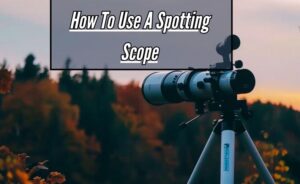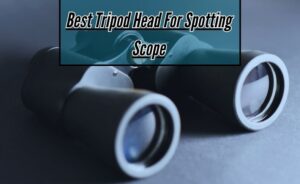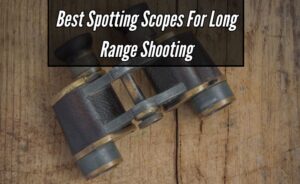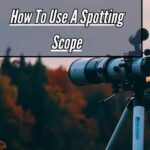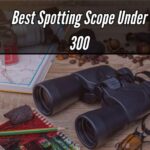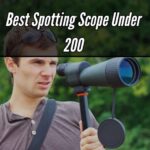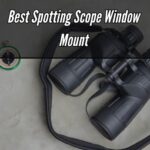Want to have a closer look at birds because you find their vibrant world fascinating? at either case, you’re at the right spot! The practice of birding, which involves seeing and classifying birds in their natural habitat, may be quite enjoyable. Spotting scopes are a must-have item in your toolbox if you want to improve your birding experience.
How To Use A Spotting Scope For Birding? Put a spotting scope on a sturdy tripod before using it to observe birds. To get a clear picture, zoom in and out as necessary. Utilize the scope to find birds at a distance before adjusting the focus for a clear image. To identify species, don’t forget to utilize a field guide or a birding app. It could take some time to find elusive birds, so be patient. Observe birds with joy!
A spotting telescope is similar to a magic window that enables you to see fine details that you may otherwise miss with the naked eye or binoculars by bringing faraway birds close to you. Learn how to utilize a spotting scope to take your birding expeditions to a whole new level, no matter how experienced you are with the hobby.
Mastering the Art of Spotting Scopes: A Birdwatcher’s Guide
Birdwatching is a fascinating hobby that allows you to connect with nature and observe the beauty of avian creatures. To truly immerse yourself in this wonderful world of birds, it’s crucial to master the art of spotting scopes.
In this guide, we’ll explore the essentials of spotting scopes and how they can elevate your birdwatching experience.
Understanding Spotting Scopes:
Spotting scopes are powerful telescopes designed for terrestrial use. They offer high magnification and clarity, making them invaluable tools for birdwatchers.
These scopes are different from binoculars in that they provide a single, magnified view of your subject, making it easier to identify distant birds.
Using Spotting Scopes Effectively:
Proper technique is crucial when using spotting scopes. Start by locating the bird with binoculars, then switch to the spotting telescope for a closer look.
Use a tripod to stabilize the scope and reduce hand tremors, resulting in a steadier image. Adjust the focus and zoom carefully to maintain clarity.
Field Conditions Matter:
Birdwatching often involves varying weather and lighting conditions. Be prepared with appropriate accessories such as lens hoods to reduce glare, eyepiece covers to protect against dust, and waterproofing for rainy days. Understanding how these factors affect your scope will help you adapt to changing conditions.
Spotting Scopes for Digiscoping:
If you’re interested in capturing the beauty of birds through photography, digiscoping is an option. Attach a compatible camera to your spotting scope using an adapter.
This allows you to take stunning photos and videos of your avian subjects, further enhancing your birdwatching experience.
Ethical Birdwatching:
Responsible birdwatching is crucial for the well-being of the birds and their habitats. Keep a respectful distance from nesting sites, avoid making loud noises, and refrain from using flash photography. The goal is to observe and appreciate these creatures without causing them harm.
Choosing the Right Spotting Scope for Birding Adventures
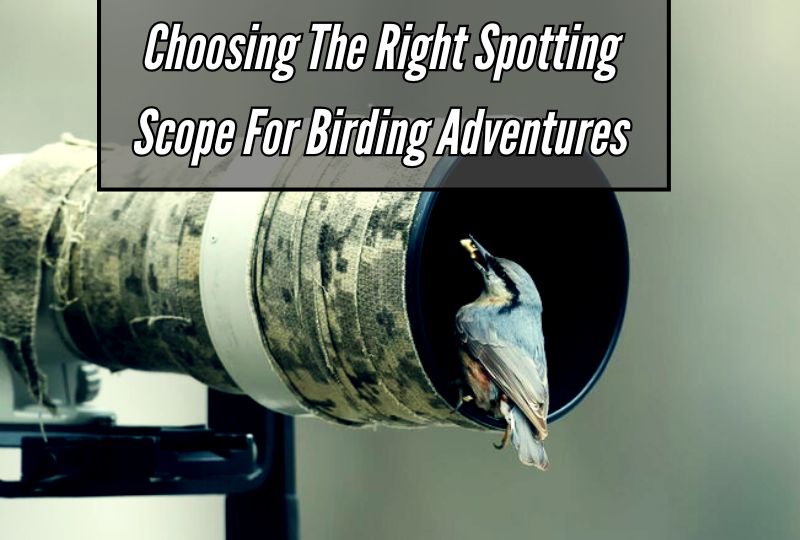
Birdwatching is a fun pastime that enables us to appreciate nature and get up close to our feathered friends.
It’s crucial to choose the ideal spotting scope for your birding excursions in order to improve this experience. Here are some crucial elements to take into account when choosing:
Objective Lens Diameter:
One of the first things to look for is the objective lens diameter. A larger objective lens allows more light to enter the scope, providing a brighter and clearer image. For birding, a lens diameter of 60-80mm is generally sufficient.
Magnification Power:
While high magnification may seem tempting, it can make the image shaky and reduce the field of view. Opt for a spotting scope with moderate magnification (usually 20-60x) to strike a balance between zooming in on details and having a wider view to locate birds easily.
Prism Type:
Spotting scopes typically come with two types of prisms: Porro and Roof prisms. Porro prisms are bulkier but offer better image quality, while Roof prisms are more compact and lightweight. For birding, Porro prisms are often preferred due to their superior optical performance.
Waterproof and Fogproof:
Nature is unpredictable, and birdwatchers often find themselves in various weather conditions. Ensure your spotting scope is both waterproof and fogproof to withstand rain, humidity, and sudden temperature changes without compromising on performance.
Size and Weight:
Portability matters, especially when you’re on the move. Opt for a spotting scope that strikes a balance between being lightweight for easy transport and having a sturdy build for stability during use.
Angled or Straight Eyepiece:
Spotting scopes come in angled and straight eyepiece designs. Angled scopes are more comfortable for group birding, allowing multiple viewers to adjust the eyepiece height.
Straight scopes are better for solo birdwatching and offer quicker target acquisition.
Coatings and Glass Quality:
Look for scopes with fully multi-coated lenses, which reduce glare and improve image clarity. High-quality glass and coatings enhance color fidelity and sharpness, ensuring you can spot intricate bird markings with precision.
Beyond Binoculars: Maximizing Birdwatching Potential with Spotting Scopes
Enthusiasts of birdwatching are constantly searching for methods to improve their encounters and get up close to the action. Although binoculars have traditionally been the preferred instrument for observing birds, spotting scopes are an additional piece of gear that can significantly enhance your birdwatching experience.
With the increased magnification and clarity provided by these potent optical instruments, birdwatchers can notice details that they might otherwise miss while using only binoculars. We’ll look at how using spotting scopes can help you get the most out of your birdwatching experience in this article.
Understanding Spotting Scopes:
It’s important to know what spotting scopes are and how they differ from binoculars before getting into the mechanics of using them for birdwatching. Spotting scopes are simply telescopes with larger objective lenses that are intended for terrestrial viewing. They have a higher magnification than binoculars.
Choosing the Right Spotting Scope:
A few things to think about while choosing the ideal spotting scope for birding are the objective lens size, general build quality, and magnification power.
Seek for a scope that strikes a good compromise between performance and portability so you can take it with you to your preferred birdwatching locations without compromising on image quality.
Setting Up for Success:
Optimizing the performance of your spotting scope once you’ve selected the best one requires careful configuration.
This entails setting up the scope on a sturdy tripod, adjusting the eyepiece for comfortable viewing, and fine-tuning the focus to get clear, sharp photographs of your feathered targets.
Techniques for Effective Birdwatching:
Although spotting scopes have remarkable magnification, the use of them necessitates skill and training. For a more natural viewing experience, try moving your scope slowly and deliberately around your field of vision, using the zoom option to focus on birds that catch your attention, and keeping both eyes open.
Capturing Memories:
Spotting scopes can be used for digiscoping, a method that includes mounting a smartphone or digital camera to the scope in order to take pictures and movies of far-off birds in addition to real-time bird observation.
You can record and share your birdwatching excursions with others if you have the appropriate gear and adapters.
Respecting Wildlife:
Ultimately, it’s critical to keep in mind that the goal of birdwatching is to respect and appreciate nature. To ensure that you and the birds may enjoy the experience without harm, keep a safe distance, avoid disturbing birds or their habitats, and follow ethical rules for birding.
Advanced Techniques for Spotting Scope Birding

Birdwatching is a popular and rewarding hobby that allows enthusiasts to connect with nature and observe various bird species in their natural habitats.
To enhance the birding experience, advanced techniques for spotting scope birding have emerged. These techniques employ specialized tools and knowledge to make birdwatching more enjoyable and successful.
Choosing the Right Spotting Scope:
Selecting an appropriate spotting scope is the foundation of successful birdwatching. Look for scopes with good magnification, clarity, and a wide field of view.
A larger objective lens diameter also aids in capturing more light, making it easier to spot birds in low-light conditions.
Tripods and Mounts:
Steady observation is crucial in birdwatching, especially when using high-powered scopes. Using a tripod or mounting system helps stabilize your scope, reducing hand tremors and allowing for extended periods of comfortable viewing.
Field Guides and Apps:
To identify the birds you encounter, carry a reliable field guide or use bird identification apps. These resources provide information about bird species, their calls, and their habitats, aiding in quick and accurate identification.
Digiscoping:
Capturing memorable birding moments is now easier with digiscoping. This technique involves attaching a smartphone or digital camera to your spotting scope to capture high-quality images and videos of the birds you spot. It’s a great way to document your sightings and share them with others.
Understanding Bird Behavior:
Advanced birders often spend time learning about the behavior of different bird species. Understanding their feeding habits, nesting preferences, and migration patterns can help you anticipate where and when to find specific birds.
Patience and Stealth:
One of the most critical techniques in birdwatching is patience. Birds can be skittish, so approach quietly and avoid sudden movements.
Settle in, wait, and let the birds come to you. Patience can reward you with exceptional birding experiences.
Joining Birdwatching Communities:
Engaging with local birdwatching clubs or online communities can be highly beneficial. You can learn from experienced birders, share your own discoveries, and even participate in group outings to explore new birding locations.
Capturing the Beauty of Birds: Spotting Scope Photography Tips
Birdwatching is a fascinating hobby that allows us to connect with the natural world and appreciate the incredible beauty of birds. One of the most rewarding aspects of birdwatching is capturing these winged wonders through photography.
Spotting scope photography is a technique that enables enthusiasts to take stunning pictures of birds in their natural habitat. In this guide, we will explore some practical tips to help you enhance your spotting scope photography skills and capture the beauty of birds like never before.
Choosing the Right Spotting Scope and Camera
Before you embark on your bird photography journey, it’s essential to invest in the right equipment. Select a high-quality spotting scope with excellent optics and a sturdy tripod for stability.
Additionally, choose a camera with manual settings that allow you to control exposure, focus, and shutter speed.
Mastering the Basics of Spotting Scope Usage
Understanding how to use your spotting scope effectively is crucial. Practice adjusting the magnification, focus, and eyepiece to get a clear, sharp image. Ensure your scope is properly aligned with your camera to avoid distortion.
Patience and Observation
Birds are often elusive and may not stay in one place for long. Patience and keen observation are your allies. Spend time watching the birds’ behavior and movements, so you can anticipate their actions and capture the perfect shot.
Lighting and Composition
Lighting plays a significant role in photography. The best times for bird photography are during the golden hours, shortly after sunrise and before sunset, when the light is soft and warm.
Pay attention to composition, framing your shot to include natural elements like branches or foliage to add depth and context to your images.
Continuous Learning and Practice
Spotting scope photography is an art that improves with practice. Take the time to learn from your mistakes, experiment with different settings, and continuously refine your skills. Joining a local birdwatching group or online community can provide valuable insights and feedback.
Post-Processing and Sharing
After your birdwatching adventure, don’t forget the final touches. Use photo editing software to enhance your images’ colors, sharpness, and remove any unwanted elements.
Share your beautiful bird photographs with fellow enthusiasts and inspire others to appreciate the avian world.
Conservation and Ethical Birding: Using Spotting Scopes Responsibly
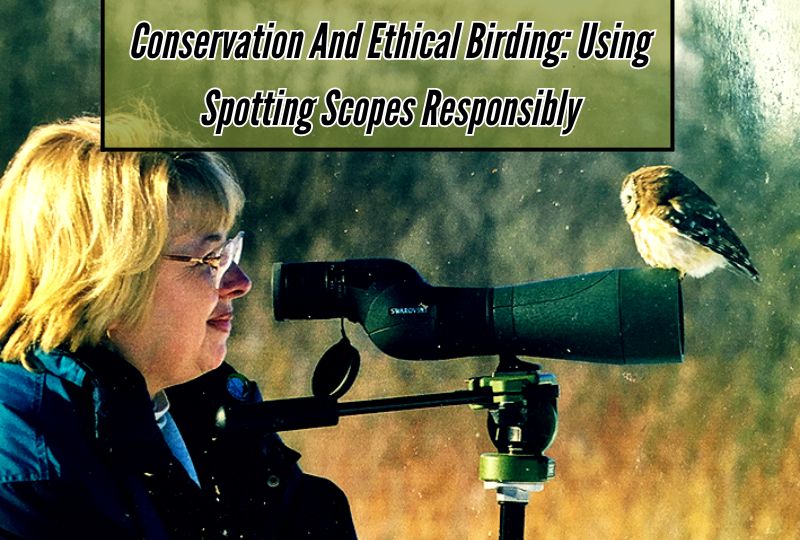
Birdwatching is a fun pastime that enables us to enjoy nature and the beauty of bird life. To protect the welfare of birds and their habitats, it is crucial to birding responsibly.
The spotting scope is a useful instrument for birding, but it must be used morally and thoughtfully to reduce its influence on the birds and their environments.
Understanding Ethical Birding
Ethical birding involves observing birds without causing harm or disturbance. It means respecting the birds’ natural behaviors, habitats, and well-being.
This approach encourages bird enthusiasts to be responsible and environmentally conscious while enjoying their hobby.
The Role of Spotting Scopes
Spotting scopes are optical devices that magnify distant objects, making them a favorite tool among birdwatchers.
They enable observers to get closer views of birds without intruding on their space. However, it’s crucial to use these scopes responsibly to maintain the sanctity of the birding experience.
Selecting the Right Spotting Scope
When choosing a spotting scope, opt for one with a suitable magnification level and a wide field of view. This will allow you to observe birds without the need for excessive zooming, which could stress the birds and disrupt their natural behavior.
Respecting Bird Habitats
Birds rely on specific habitats for nesting, feeding, and resting. As ethical birders, it’s our responsibility to stay at a safe distance to avoid disturbing these areas.
Use your spotting scope to observe from afar, minimizing the need to approach nesting sites or feeding grounds closely.
Avoiding Excessive Playback
Playback is the practice of using recorded bird calls to attract birds for better viewing. While this can be an effective tool, it should be used sparingly and considerately. Overuse of playback can stress birds and disrupt their daily routines, so exercise caution.
Practice Patience and Caution
Resist the urge to chase after rare birds or approach them too closely for the perfect shot. Instead, practice patience and give the birds the space they need to thrive. Keep a respectful distance and use your spotting scope to bridge the gap between you and the birds.
Leave No Trace
Finally, leave no trace of your presence when birding. Take care not to disturb the environment by trampling on vegetation or leaving litter behind. By practicing Leave No Trace principles, you help preserve the natural beauty of bird habitats.
Conclusion
In conclusion, you may really improve your outdoor experience when birdwatching with a spotting scope. Using a spotting telescope to zoom in and view far-off birds in crisp, detailed views gives up a whole new world of birdwatching opportunities.
You can get the most out of every birdwatching excursion and optimize the performance of your spotting scope by heeding the advice and methods provided in this guide. As you discover the exciting world of birdwatching through your spotting telescope, keep in mind to be patient, remain vigilant, and appreciate the beauty of nature.
Frequently Asked Questions (How To Use A Spotting Scope For Birding)
How do you use a spotting scope for birding?
When birding, a spotting scope is a useful tool for getting a closer look at wild birds. Install your spotting scope on a sturdy tripod before using it. You may maintain it steadily and avoid unsteady perspectives by doing this. After then, point the scope roughly in the general direction of the bird you wish to see.
Use the focus knob to sharpen the image and adjust your vision. To locate the bird quickly, you must start with a low magnification eyepiece. Once you have located the bird, you must switch to a higher magnification for a more detailed view. To track the bird’s movements, be persistent and move the scope gently. In order to ensure comfortable viewing, utilize the adjustable eyecup as well, especially if you wear glasses.
Are spotting scopes good for bird watching?
Spotting scopes are indeed great for seeing birds. Compared to binoculars, they provide better magnification and clarity, enabling you to observe birds in fine detail even at a distance.
Because of this, spotting scopes are especially helpful for recognizing species that have distinctive characteristics that may not be seen with the unaided eye or binoculars. They are useful for seeing birds in their natural environments, such as cliffs or wetlands, where the birds may be farther away.
What magnification spotting scope for bird watching?
For bird watching, it’s crucial to achieve a balance while selecting the spotting scope’s magnification. The best option is typically a spotting scope with a 20x to 60x magnification range. With this range, you may start out at a low magnification to find birds quickly and then increase the magnification for a closer look.
Due to greater jitter and a more condensed field of view, higher magnifications might be difficult to maintain an image. Therefore, a scope with variable magnification within this range offers flexibility for birdwatching.
At what distance do you need a spotting scope?
The type of birding you do will largely determine whether you need a spotting scope for bird watching. Binoculars will likely be adequate in the majority of circumstances if you like casual birdwatching in a nearby park or your home.
A spotting scope, however, becomes crucial if you’re a serious birder or wish to study birds in open spaces, wetlands, or while birding from a distance. It makes birdwatching more enjoyable by enabling you to get a closer, more thorough look at distant species. Therefore, the range of distances at which a spotting scope is required varies, but it becomes more important when birding in wider, open areas.
Should I use a straight or angled spotting scope for birding?
The decision between a straight and an angled spotting scope for birdwatching boils down to comfort and personal taste. Beginners find it easier to use a straight spotting scope since it makes tracking and finding birds easier because it aligns in a straight line with the eyepiece.
Conversely, an angled spotting scope gives you greater viewing angle flexibility, which is useful for sharing the scope with other birders or birders of different heights. The best option for you might be a straight spotting scope if you want a more simple and direct method. However, an angled spotting scope can be the better option if you value adaptability and convenience of sharing with fellow bird watchers.
Is a spotting scope better than binoculars for bird watching?
There are benefits to both binoculars and spotting scopes when it comes to bird watching. Spotting scopes provide greater magnification and improved clarity over longer distances, making them useful for long-distance viewing. When monitoring birds in open spaces or around huge bodies of water, they are especially helpful.
Binoculars, on the other hand, are more transportable and adaptable, enabling a greater field of vision and simpler movement in dense vegetation. For individuals who would rather take a more relaxed approach to bird viewing, binoculars are an excellent tool. The decision between binoculars and a spotting scope ultimately comes down to your personal preferences and the kind of birding you want to perform.


